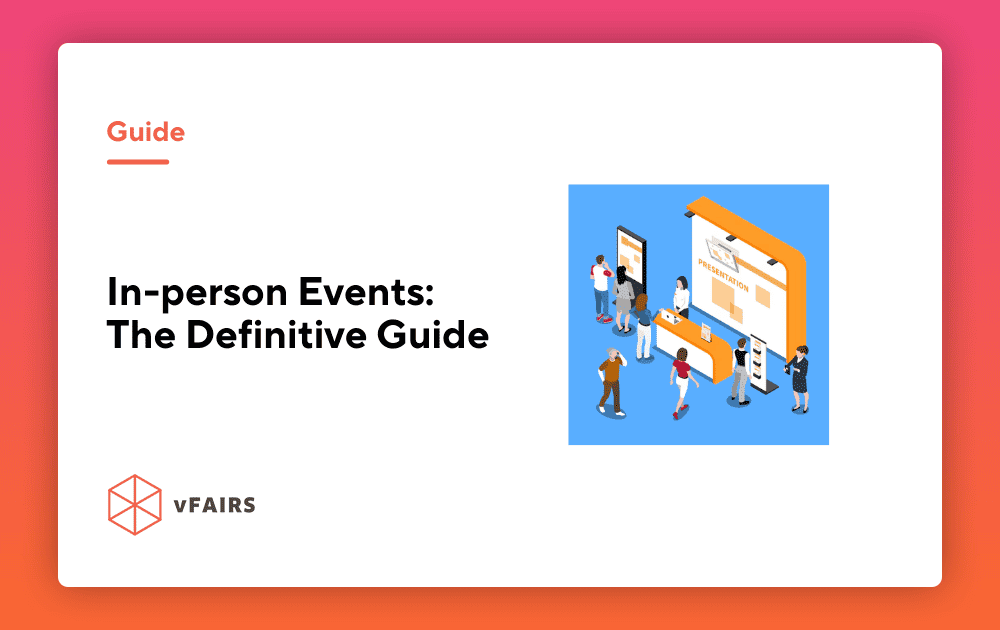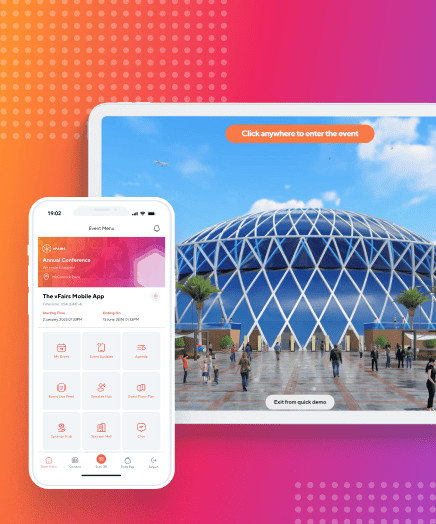In-person events are hard to replace, almost impossible.
They might have eluded the world for a while, but we never forgot about them, and now that they’re well and truly back, in-person event management is again a red-hot topic.
If you’re an event organizer, in-person events are more than likely to be a part of your events strategy this year. With all the latest advancements in event tech, the events industry has completely changed how we host in-person events. In this comprehensive guide, we talk about all there is to know about in-person event management, in-person event technology, and more.
Chapter 1: In-Person Events Fundamentals
Overview of In-person Events
Within the events sector, there has been a significant amount of change over the previous year or so. Before the COVID-19 pandemic, the primary method for organizing an event was to have attendees physically present. In-person events are extremely effective because they offer the opportunity for human interaction.
In-person gatherings are ideal for meeting new people, catching up with old friends, colleagues, and industry peers, and gaining new chances for your career or personal life. One of the most appealing aspects of attending events in person is the opportunity to engage in conversation with other people.
Importance of In-person Events
According to a survey conducted by vFairs on LinkedIn regarding the importance of in-person events, 67% of individuals said that in-person events are extremely important while 25% people said that they are fairly significant.
Conventionally, organizers host an event by having attendees physically present at the venue. As we all know, that hasn’t been possible over the past few years. Virtual events have many benefits, such as the ability to quickly and easily reach more people and gather a lot of information about the people who attend. But, even though they will always have amazing benefits for businesses, they don’t bring people together the way in-person events do.
What Are The Advantages of In-Person Events?
Both virtual and in-person events have their benefits. However, if given the option, individuals prefer attending events in person. This is because it might be challenging to maintain audience attention during virtual events. Generally, it takes a very short period of time for a person to start daydreaming or become disengaged in an activity under typical circumstances. When examining the number of tabs that attendees will open during a session, it is clear that online events make disengagement much simpler.
In addition, in-person events provide the experience of being at an event with individuals who share your passions and interests as well as the opportunity to meet with new people. It is clear that in-person networking events give a better possibility of successfully closing a business than virtual ones do. In any event, making new connections is one of the most important parts of the overall experience. Attendees who engage in social interaction and network building will have a greater number of opportunities to make new connections, unearth prospective clients or business partners, and cultivate relationships with other individuals who share their interests and passions.
Are In-Person Events Better Than Virtual Events?
While many would prefer physical events over online events because of personal interactions and engagement, they aren’t feasible for all. They can be costlier, need a more intense planning process, and have obvious logistical and geographical constraints. Therefore, no one can say that hosting an in-person event is always better. However, if you have the budget, there’s nothing quite like it to build community through audience engagement.
Benefits of Hosting an In-person Event
Personalized Feedback
Face-to-face events allow the organizers to do more than just create relationships; they also enable them to receive feedback from attendees on a more intimate level. You can monitor the atmosphere in the conference hall, for example, and immediately make any necessary adjustments to enhance the quality of the event.
Higher Engagement

People are more interested in in-person events because it’s almost impossible to ignore them when they’re there. You can do this by reading people’s body language, nonverbal cues, and tone of voice in addition to what they say. This will give you the courage to speak up. Face-to-face interactions also help people avoid misunderstandings that make them less likely to share their thoughts or ideas.
Pros of In-person Event for Attendees
Face-to-face Interaction
The ability to mingle and make new connections is a major perk of doing an event in person. Whether you’re looking to expand your professional or personal network or simply make new friends, face-to-face gatherings are a great way to do all three. The ability to engage with other individuals is a massive attraction for many people to attend events in person.

Reconnecting with Clients and Partners
Although it is possible to maintain and grow relationships with current clients, partners, and industry peers through virtual channels such as video chats, emails, and phone conversations, there is no substitute for in-person meetings. Relationship-based businesses can’t function without regular face-to-face contact. Meeting many clients and partners in one place over a few days is a significant perk of attending huge industry events.
7 Popular Types of In-person Events
Conferences
Conferences are common among B2B marketers. Most of the time, at least 100 people show up to a conference, and most of them have an interest in the topic. The goal of the conference is to talk about a certain topic and bring attention to a certain issue. After this, there is a period of debate about a related current issue, to bring about change.
A lot of the time, one or more speakers who are experts in their field talk to an audience of professionals or people who share interests in the same thing.

Summits
A summit is different from a conference in that it is usually only for top-level executives or influential people in an organization or industry.
Most of the time, it is a one-time, separate event with a fairly narrow topic and agenda. Usually, you can only attend and speak at a summit if the organizer invites you.
Trade Shows
Trade shows give you a chance to show off your newest products and introduce your brand to other businesses or the general public. Since the point of a trade show is to show off products, it usually takes place in a large space that can fit a lot of vendors. Because of this, they are a great way to find new sales leads.
Also, trade fairs are a great place for entrepreneurs to meet new people and find new customers. It’s a great way to fill up your address book and meet new people.
Seminars
Seminars are a lot like conferences in how you plan and run them. This time, though, the focus is more on learning, training, and passing on information. Even though there may be a lot of people there, they are often split up into smaller groups for better training.
Small groups can meet for sessions, and then everyone can get together to talk, network, and share ideas. Depending on the size and scope, you can organize seminars anywhere. You would need a place with smaller rooms or areas for learning and larger areas for getting to know people.

Career Fairs
Career fairs are hiring events for organizations trying to fill numerous posts across departments, and great for candidates to speak with company reps about the culture and future chances (even if they’re not applying for anything at that moment. If you come to the career fair with a good “elevator speech,” which is a 15-to-30-second summary of your skills and interests, you can connect with hiring professionals in a meaningful way.
Job Fairs
Job fairs are events where multiple organizations compete with one another to get attendees to fill open positions at the same venue. In most cases, organizations, schools, or programs run by the government sponsor them. Most of the time, companies at a job fair have open positions that they hope to fill with the help of the people who attend.
Internal Events
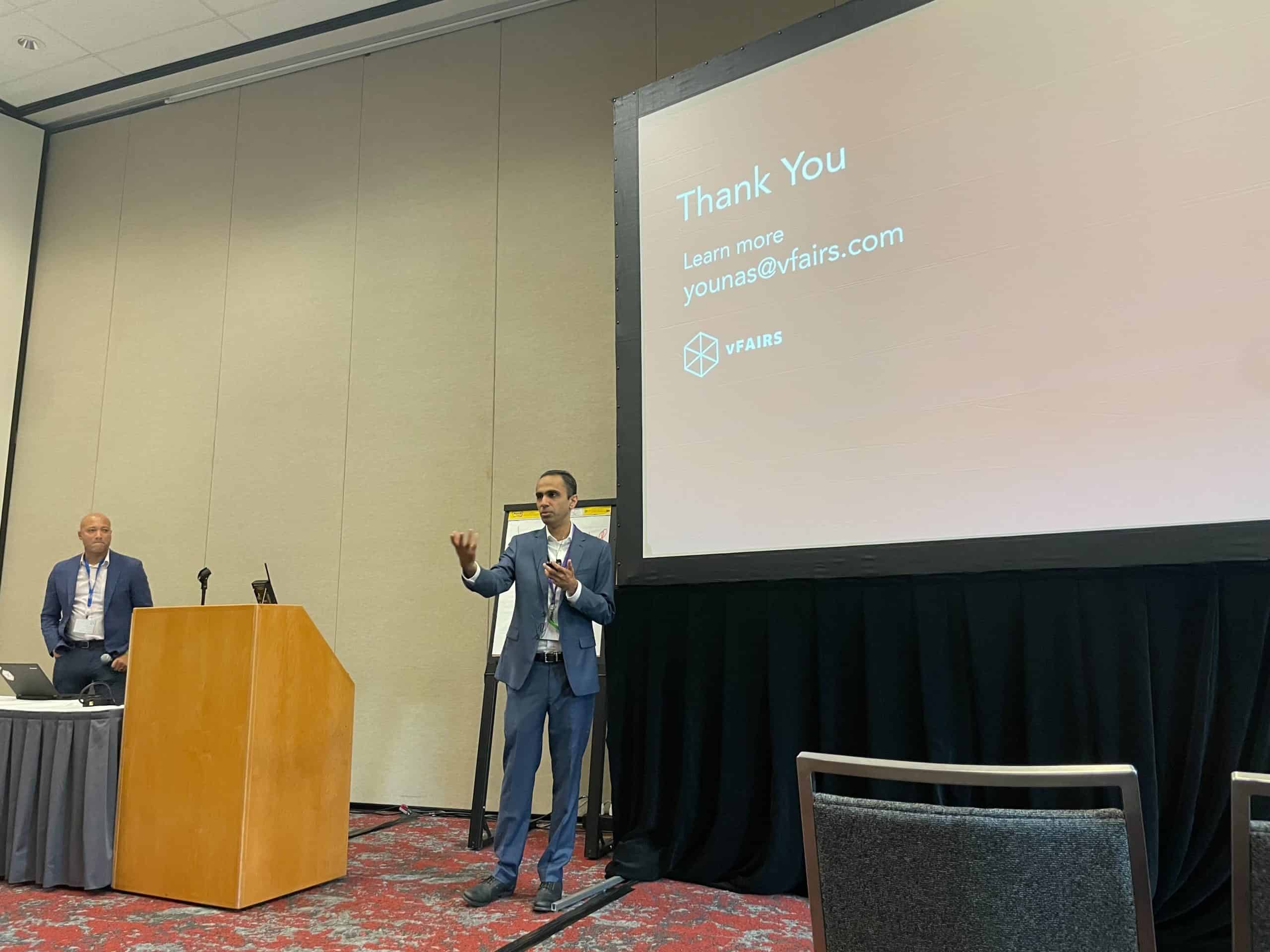
Any meeting, convention, or other private event that a company organizes and pays for is considered an internal corporate event. The usual goals of a corporate internal event are staff engagement and alignment, stakeholder and board member education, and information dissemination.
Physical vs. Virtual vs. Hybrid Events
How Are Physical Events Different From Virtual and Hybrid?
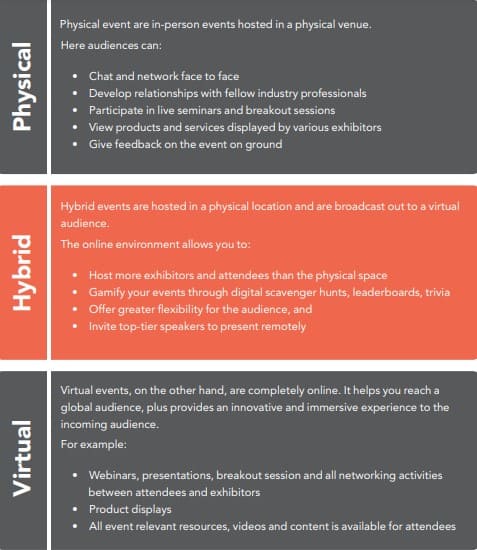
In-person events are picking back up around the world. If prepared with adequate attention and lead time, they may deliver an engaging, memorable experience for your attendees. Here’s how in-person events differ from virtual and hybrid events:
- Connection: When you’re face to face with your audience, you can easily build richer, more meaningful experiences for them.
- Retention: Attendees are more likely to retain the information presented at a live event.
- Experience: An in-person gathering is more exciting than ever after a year of virtual communication. People will remember your event long after the novelty wears off. In addition, there are many more options for interaction, entertainment, and motivation at live events.
- Intent: Attendance at an event is a wonderful way to gauge consumer interest in your product or service, as it shows that people care enough about the topic to take time out of their busy schedules to listen to what you have to say.
- Longevity: Marketing campaigns can benefit from the unique footage and photos captured at live events.
In-Person Meeting vs In-Person Event
In-person meetings can be one-time or recurring activities. They usually last between half an hour to several hours but mostly focus on one or two important points of discussion. The meeting agenda and attendee list are decided beforehand and the setup can be simple.
In-person or physical events usually last from several hours to several days and are socially-driven events. In-person events can include in-person meetings as a part of the event agenda. The event setup is much more demanding and the guest list is usually longer than a meeting as well.
Will In-person Events Replace Virtual Events?
According to a survey conducted by vFairs in 2022, 95.5% of people said that at least some form of a virtual event is going to be a part of their events strategy. This means that virtual events will not replace in-person events. However, people will prefer a mix of both i.e. hybrid events.
If you only talk to people online, it’s almost impossible to get close to them. You lose social cues like body language, and you’re more likely to be distracted by what’s going on around you and open new tabs on your computer. People want to meet new people and make connections with them. Face-to-face events are not only fun to go to, but they also give you a lot of chances to connect with other people in ways that you can’t do online.
People talk to each other in many different ways besides just words. Most of the time, people can explain themselves and share information much better in person than they can online. When people talk to each other in person, they can move the conversation along more naturally and pick up on important body language cues. Also, when you’re face-to-face with someone, it’s much easier to see how excited and passionate they are about what they’re talking about, which makes you more interested in the conversation. Plus, one person rarely talks over the other by accident, which happens a lot in online conversations.
There is a reason for virtual meetings, trade shows, and other events. They will never be as good as talking to someone in person, though. Face-to-face communication is better than online communication because it helps people make the social connections they need to do well.
Chapter 2: How to Plan an In-Person Event
What Is Required to Host an In-person Event?
Following are the key factors you need to consider while hosting an in-person event:
Aims and Goals for an Event
Start by writing down the goals of your event. What do you want? Why do you want to make this event? The goals should be clear and measurable. The plans and actions you use to reach the goals you’ve set are your objectives. To clarify your goals, list important questions.
Make sure you have a general idea of what will happen. Start by answering these questions:
- How long will the event go on? One day? How long has it been? Or will it last for 4 hours?
- How will the event be set up? Will there be a keynote speech, a panel discussion, or a hands-on workshop?
- How many streams run at the same time? The subject of each stream?
- How will the networking work?
Venue
The size of the venue is one of the most important things to think about. You need to know how many people you think will come. Make sure you have a good idea of how many people will be there, as this could directly affect where you can hold the event.
You should know how many people can fit in each room. Will the people who want to go to each session be able to fit in a room? Or do you have to put them in different rooms?
Speakers
Next, you need to decide who will speak at your event. It’s helpful to get your speakers on board early so you can use them to promote the event. The call for speakers has a snowball effect: it’s hard to get the first one, but after that, there will be a lot more to choose from.
Start with friends and people you know (clients, business partners, old connections).
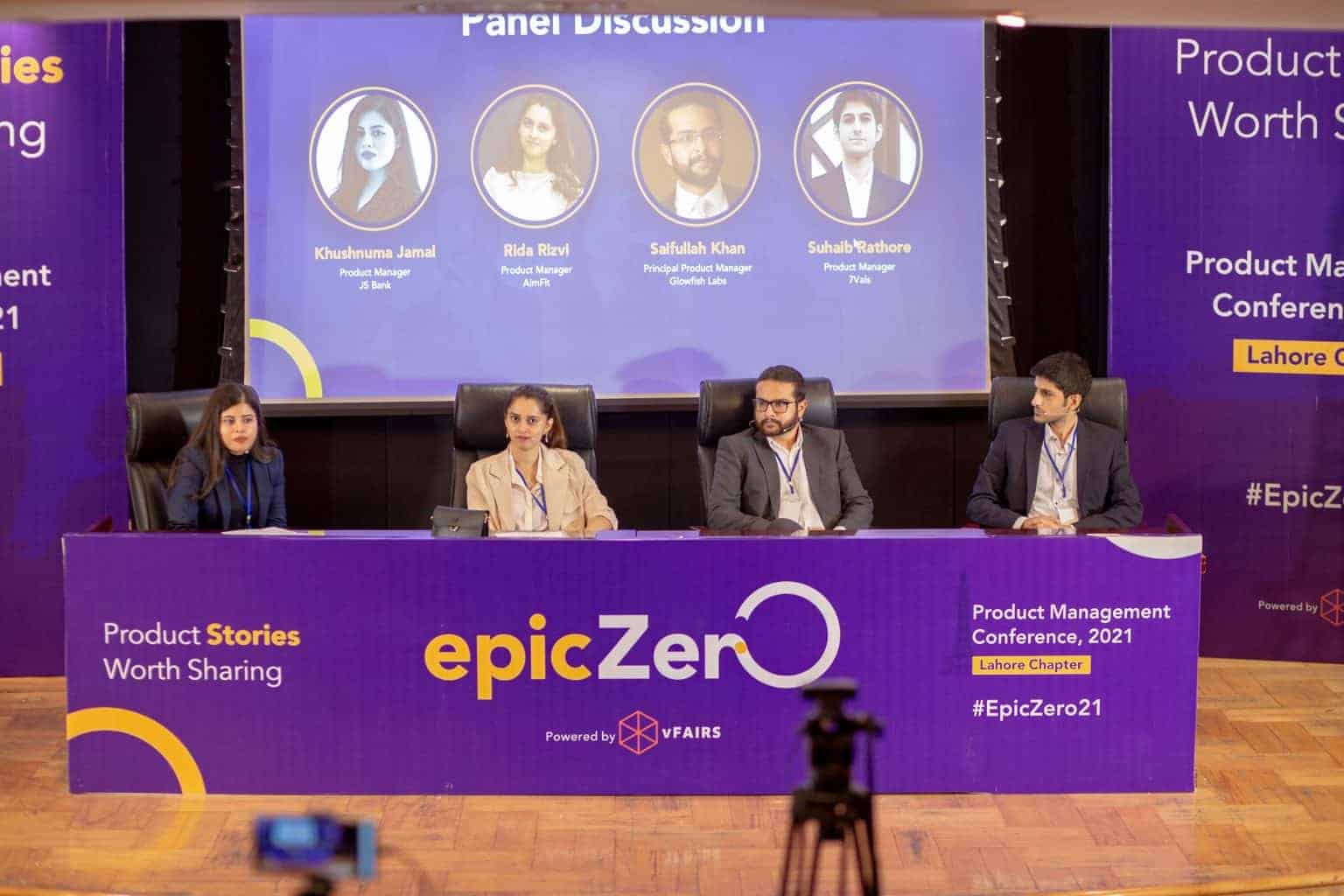
Promotional Plan
First, make sure your website has all the important information about the event. This is a must if you want to be successful. Attendees and participants should both know what they are signing up for and how it will help them. You can get more people to come by sharing photos and information about the event on social media. If you have hosted an event before, you can share testimonials from past attendees to gain the trust of people who might want to come to your next event. Send regular emails or newsletters to your email list and event attendees to keep in touch with them.
How to Find the Best In-person Event Venues
Your planning will go much more smoothly if you can find a venue team that cares about the health and safety of your community and will help you do that. Think about what will make the people who are there happy and comfortable.
Explore Indoor-outdoor Venue Options
Consider locating a site with both indoor and outdoor spaces so everyone can spread out and there is plenty of fresh air. This will make space for people who want to avoid big groups of people.
From there, make a floor plan to figure out what will go inside and what will go outside. And don’t forget to think about extra costs and logistics, like setting up Wi-Fi, building technical infrastructure, and planning for unfortunate weather. Consider making a list of what your guests need so you don’t miss anything when you’re looking for a venue.
Get Enough Comfortable Space for Social Distancing
When it comes to getting to know people at events, people may have different levels of comfort. Some people are understandably uncomfortable getting too close and personal. Plus, according to public health guidelines, those 6 feet of social distance go a long way. They should be a part of your in-person event playbook.
Make sure to think about whether your venue’s maximum capacity will give your staff and attendees enough room to mingle (especially in break areas).
Consider Clean-space Venues
Even before the pandemic, the events business made sure that attendees were safe. Now, venues are doing more to keep their spaces clean and make sure their guests are safe.
Look for a place that puts the health of the attendees first. From touchless check-in kiosks and hand sanitizer stations to prepackaged meals and no-line food service, a lot of places are coming up with new ways to keep health and safety in mind.
How Do You Engage People at an In-Person Event?
In-person events are all about high engagement and the possibility of making real connections. Engaging people at an in-person event starts with planning exciting activities in between sessions. These can be lunches, team-building activities, fun games, or throwing an after-party. Attendees will thank you for it!
7 In-Person Event Ideas for High Attendee Engagement
Here are some of the best in-person event ideas that will help you boost attendee interactions and engagement at your event:
1. Ice Breaking Sessions
Attendees at your event want to network and make connections but striking up a conversation out of the blue could be difficult. Event organizers should think of adding an ice-breaking session before the event proceedings start. This can improve the overall atmosphere and make attendees more comfortable with their surroundings.
2. Games
Fun and exciting contests can add a wow factor to any in-person event. Easy-to-play games like musical chairs or pictionary can help attendees be more engaged at the event and have fun as well. Nothing brings a group together more than competing against another so make sure you add group games as well.
You can foster conversations and connections with an on-site social media wall, QR based scavenger hunts and on-site leaderboard station.
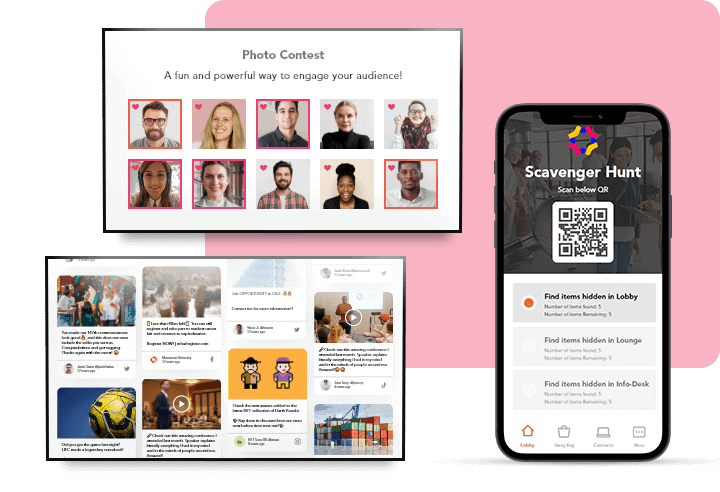
3. Team Building Activities
If your in-person event is an internal event for a company or an institution, then team building can be a necessary thing to consider. You can set up various team-building activities such as truth or dare, acting skits, or other activities. The main goal should be to bring everyone together to achieve a mutual goal.
4. Celebrity Speakers
Inviting a celebrity such as an actor, influencer, or sportsperson as a guest speaker to your event can hype it up for all your attendees. Attendees will show up for star power at your in-person events and this strategy is always a winner.
5. Polls and Feedback Surveys
If you aren’t sure how attendees are taking your in-person event you can set up live event polls using in-person event technology. Mobile event apps can allow you to set up feedback surveys to engage attendees and also understand what’s working most for you.
6. Event Swag
Branded t-shirts, keychains, tote bags, and stress balls make excellent swag products for your event. You can make small giveaway bags with a few items and give them to each attendee. You can also use these items as prizes to give to winners of any games you have planned for the event.
7. After-Party
After the event is over, you still want to engage attendees and make it even more memorable for them. A final lunch or an after-party can set the right tone so that your event is engaging, fun, and truly epic.
Roadmap to Hosting In-person Events
Planning an event is a huge job, whether it’s for a small meeting or a large conference. No matter how simple or complicated an event is, you need to plan and organize it in detail.
1. Choose Your Event
First, decide what kind of event you’ll host. Your team can hold many different events, unlike webinars, Zoom networking events, digital conferences, etc. Popular marketing events include:
- Trade Shows, conferences, expos
- Roundtables, workshops, seminars
- Happy hours, parties, networking, etc.
Knowing and sticking to your event kind can help you determine budget and implementation. When choosing an in-person event format, keep in mind that it must meet your business goals and strategy.
2. Finalize Your Budget
Having a clear budget before planning begins will keep your team on goal, ensuring nothing goes out of hand, and help them gauge progress. Budgeting helps clarify other areas of event preparation. Budgeting helps avoid surprises (like running out of money for decor, etc.). You’ll be more effective if you plan your budget, update it as you finalize variables, and monitor the process closely.
3. Build Attendee List
No matter what kind of event you’re organizing, you want the right people to come. This means the people who will a) get the most out of your event, b) bring something valuable to your organization, like a new lead or an upsell, or c) give you another way to spread the word about your value proposition. Create a profile of your ideal attendee, and then focus your advertising on these people for the biggest impact.
4. Pick Your Venue and Date
Choosing a place to hold your event and a date for it are two important decisions that will affect the rest of your project plan. Start looking into places as soon as you can. The market for events is busy, so it’s important to find a time when venues will be open. When choosing a venue, you’ll also need to think about the best time of year for things like travel and costs.
5. Develop Event Branding
From the name and theme of your event to how it looks and feels on-site, your event’s branding sets the tone for the whole experience. You want your event to have a strong personality that stands out. A strong event brand also gives your event a goal and helps you decide where it should go. When choosing a brand for your event, keep in mind that it should match the brand of your organization but also have its brand. Also, think about how people will see your brand online and in person. Last, think about how you will incorporate your event’s brand into all facets and areas.
6. Set Agenda
Make your agenda as soon as possible! Is there going to be a keynote speaker? Will you set aside an extra day or evening for your sponsors? Would there be a single “track” of workshops and speeches, or will participants be able to choose from various programs at once? As you answer these introductory questions, you will be able to construct a high-level view of your event program.
7. Confirm Sponsors, Exhibitors, and Speakers
If you’re conducting a large-scale event, you’ll most certainly want to enlist the help of others to offset costs and display a variety of industry voices. Speakers, sponsors, and exhibitors are all popular ways to provide value to your attendees while also offsetting costs. If your event has multiple sessions, you’ll need to find speakers for each one.
Create a list of potential sponsors for your event. Conduct research before reaching out to them to see how they might benefit from attending your event. Furthermore, before reaching out to potential sponsors, prepare sponsorship packages.
An exhibitor package is another popular technique to attract sponsors. This usually means dedicating space at your event to your exhibitors. Each exhibitor sponsorship deal includes a set amount of space for your exhibitors to utilize, brand, and interact with your attendees.
How to Attract Sponsors for Your Event
Finding sponsors and supporters is a good idea if you want to make the event less expensive. But it’s sometimes difficult to properly communicate the value of your event to them. So, where do you start?
First, make a list of businesses, groups, and people who align with the themes and topics you’d like to cover during the event.
The most likely and best-fitting sponsors would be those whose audiences are similar to the event’s and whose businesses will directly benefit from their participation. Figure out what you can give the sponsors. It shouldn’t just be showing its logo or getting a few more people to visit its website.
For example, if your audiences are similar, you could give them a detailed data report, analytics, and survey results. Most of the sponsors see your event as a way to get the word out about their own business. They want to see numbers that show the event will be a success. Your offer can include a spreadsheet with information about the audience’s age, gender, how active they are on social media, etc. You can provide multiple tier options. There is a list of the options and what you will give at each level in tiered sponsor packages.
1. Select Tech Tools
Both event organizers and attendees benefit from technological advancements in the event space. When planning your next event, consider your technology requirements and implementation deadlines. You must introduce certain technologies well in advance of the event, while others can wait until closer to the big day.
2. Create a Promotional Plan
There are several ways to promote your event, depending on the size of your event and your intended guest profile. If your event is small and personal, or if you want executive-level attendees to attend, a personal invitation is a way to go. For a large conference or trade fair that you wish to make available to the public, online platforms are usually more cost-effective. Also, if other vendors will be present, be sure they have procedures for promoting to their network.
3. Analyze The Data
How many tickets did you sell, and how did you sell them? How much did each attendee pay? How many qualified leads did you receive? How many pre-orders have you received? These are some of the parameters that you can measure after the event.
In addition to quantifying the success of your event, you need also evaluate it qualitatively.
Promoting an In-person Event
Event promotion comprises utilizing various marketing channels and methods to raise awareness and encourage as many people as possible to attend an event. To sell tickets and acquire registrations from the target demographic, it uses emails, social media marketing, flyers, and direct media.
Divide your approach into three parts: pre-event, main event, and post-event, as all three are necessary for properly marketing your event. Make a documented plan that includes the steps listed below:
Recognize Your Target Audience and Stakeholders
Consider your target audience before organizing an event. Consider that event guests demand a meaningful experience to attach to your business. Investigate what captivates individuals and leaves lasting memories to better understand their desires and requirements. As a result, your major topic should address their needs, offering you a competitive advantage.
Determine Your Objectives
- Set clear targets you want to achieve.
- Figure out how you’ll measure success.
- Then, make sure you have the tools in place to accurately track your event’s performance.
For example, if you want to increase brand awareness, a specific aim would be “to receive 1,000 favorable mentions by the end of the event.” A goal like this allows you to track your progress and achievement. There are numerous examples of goals you may create while promoting an event, but make sure they are reachable and within the period of the specific event.
Create a Marketing Budget and Plan
When developing your budget for the event, keep in mind that marketing costs take up a fair amount of it. Everything about the promotion campaign depends upon the budget, including the services you hire, the venue, caterers, tents, and other hidden costs. For example, you might need software for managing events, a website, or paid digital ads. Get quotes early so you can fill in any blanks. Apps and software for marketing are great ways to keep track of the whole process.
Spread the Word
Make people aware of your event by telling them about it a few months, weeks, and days before it happens. If you’re hosting a one-off event, start promoting at least 2-3 months in advance. You want to work in some time to collect registrations and get a good head count as early as possible.
If you’re hosting an annual event, you’ll likely have promotional touchpoints year-round to keep it on people’s radars. Here are a few ideas you can use to keep your audiences engaged throughout the year:
- Recap videos of the past year’s event
- Sneak peeks at the upcoming year’s themes
- Breakout discussions about topics discussed at past events
- Special speaker announcements as they happen
- Q&As about what your audience wants to learn about at upcoming events
Apart from these, there are several other ways to spread the word about your event. You can create a plan that incorporates a mix of content and distribution channels so that you can get in front of your target audiences in multiple ways. You will want to consider whether these channels are effective for you:
- Social media
- Email marketing
- Visibility on your marketing site
- Press releases
- Paid advertising
- Print & traditional ads
- Forums & online communities
- Content partnerships & influencer marketing
Have a look at where your audiences are already, and lean into those channels. It may be worthwhile to speak with potential advertisers, partners, and influencers to understand if their audiences match yours, and set up deals to publish content to their platforms too.
Chapter 3: In-person Events Platform and New Technology
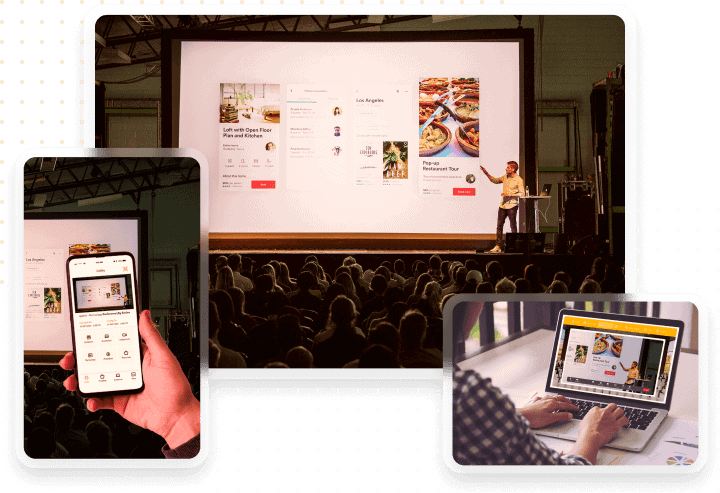
What is the Importance of Technology at In-person Events?
Event technology is changing faster than ever, and for good reason. Today, the majority of people who work in the event industry agree that technology can make their events better. Therefore, in-person event platforms are creating more innovative offerings and revolutionizing how people attend and host physical events.
Event technology allows attendees to communicate with one another before, during, and after the event, making networking easier than ever. Additionally, event apps make it much easier for organizers to alert participants to any potential schedule changes. They can also install chatbots that respond to inquiries regarding the occasion.
One of the most significant features of an in-person events platform is the availability of data insights and analytics reports for organizers. They can monitor customer behaviors, lead generation, revenue, and more.
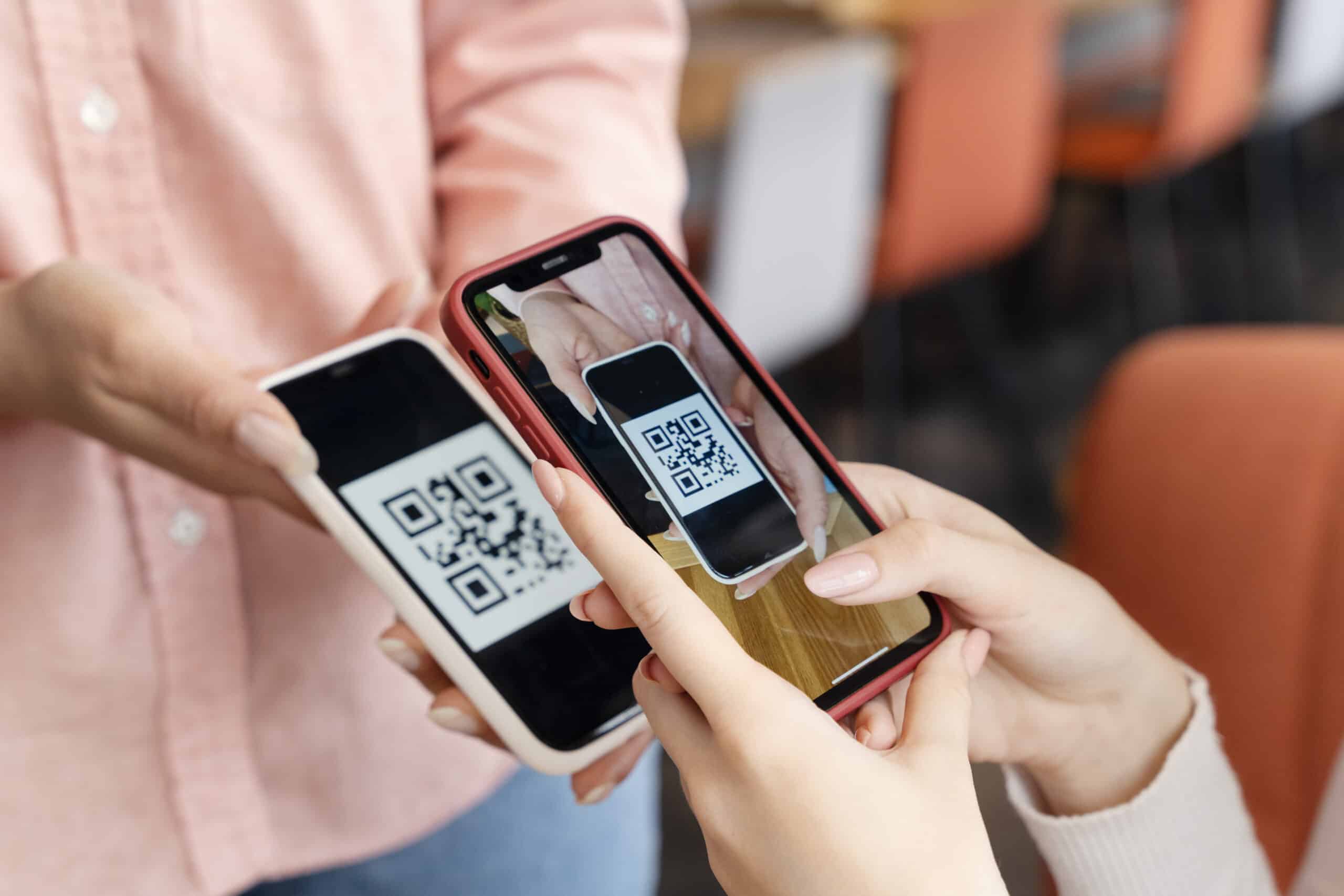
Benefits of Using Technology In Your Events
Event technology has various benefits for all stakeholders involved. Let’s dig deeper into what it has to offer to exhibitors and attendees.
For Exhibitors
- At different points in the planning process, event technology can make things easier for exhibitors and give them back some of their time.
- One of the best things about event technology is that it helps exhibitors get data insights and analytics reports. Exhibitors can keep track of how customers act, how many leads they get, how much money they make, and more.
- Event technology saves organizers a lot of stress, time, and energy because it automates many processes, such as registration, catering, and measuring event ROI.
- The technology is error-free, which helps people make fewer mistakes. Exhibitors no longer have to worry about any math or small tasks that accompany an event.
For Attendees
- Attendees can use a mobile app for an event to get all relevant information, communication, notifications, and content.
- Attendees can also let exhibitors and sponsors know they are interested in them before the event and set up meetings.
- The self-check-in kiosks let people check-in without touching anything.
- Event technology lets attendees message before, during, and after the event, making networking easier.
How To Incorporate In-Person Event Technology At Your Events
It’s time for a change if you want to streamline your events and host successful events anywhere in the world. You require flexible technology that can grow as your needs do. Here are a few tips to help you incorporate event technology into your plan seamlessly.
1. Invest in Tools That Support Your KPIs
The first step is to determine your goals and objectives. You need to have a clear understanding of your needs. Instead of blindly investing in different types of event technology platforms, you must ensure that you are investing in the tools you actually need.
2. Create An Event Planner
The next step is to create an agenda. You need to decide which technology you need and when you need it. For example, the registration form for your event will serve as the first impression of your event technology for your guests. Because of this, you should find event tech that includes easy-to-use registration forms that fit with your brand.
3. Do Your Research
Before incorporating any event tech into your event management plan, you need to do your homework. A well-researched purchase will benefit you in the longer run, considering you will keep in mind all the pros and cons while making a decision.
4. Shortlist Your Options
Once you have researched which event technology tools you need, it’s time to shortlist your options. See which options fit into your budget and which ones are worth investing in, considering your event requirements.
5. Ask For Demonstrations
When you have finally shortlisted your options, it’s best to reach out to the vendors and schedule a demo. A demo is a real-time setting where you can explore the tools thoroughly. You will be able to analyze them and see which ones to finalize.
6. Choose Which Features You Want
Once you have chosen an event tech platform, it’s time to decide which features you require. For example, you can choose the tools you need from the vFairs VenueGear.
7. Work Out a Payment Plan
The final step is to work out a payment plan. You can contact the vendors for detailed pricing plans and then see which ones fit your budget.
Features of an In-Person Events Platform
The right physical events platform will offer you an impressive tech stack to help make your event planning process a breeze. These features not only will make the event organizer’s lives easier but are also great value props for attendees and enhance the whole event experience.
Mobile Apps

During the event, people can use the vFairs mobile app to chat, look for other exhibitors, share their business cards virtually, and check-in. This will make it possible for people to take part in the live event from anywhere in the world. Attendees can also customize their schedules and choose which sessions to add to them. They can also add it to their calendars to make sure they don’t miss any important talks that day. If your attendees can’t make it to a session they wanted to go to, they can watch a replay in the app whenever they want.
One of the most exciting developments in the event industry is the rise of mobile event applications, which you can utilize in various ways to improve productivity and enhance the experience of event attendees. To begin, event apps facilitate information dissemination and permit more eco-friendly event operations. You can minimize paper waste and lessen the environmental effect of your event by making announcements, session details, speaker biographies, exhibitor details, and resources all available digitally.
Event Marketing Technology
Event marketers know that they need to give attendees something of value and match their needs with useful products, services, and information. When planning your event, you also need to think of new ways to reach attendees, get their attention, and make the event fit their specific interests. You can do this with the help of online event tech.
Email marketing tools like vFairs’ own event site pages, custom registration forms and emails are great for getting in touch with your attendees in a more personal way. You can use personalized emails, texts, and push notifications from the event app to get people excited about the event. You can also change the way you use social media to market to create more intrigue.
Moreover, you’ll have a better chance of getting people to come to your event if you address their problems and talk about things they’re interested in.
Check-in Software
If you’re hosting an event, vFairs VenueGear can help you streamline everything from user registration to badge printing and attendance tracking, giving you a clear picture of how your guests are interacting with your brand and the event.
The check-in software can offer data-driven insights through session check-ins onsite. You can easily tell which sessions were most popular among attendees and where they spent most of their time. Check-in software is also backed up directly with CRMs to help with lead capture and lead retrieval. You can scan badges of leads and send them directly to your sales people for lead scoring.
Onsite Badge Printing
In-person events don’t need to have long queues at the check-in counters anymore if you have efficient onsite badge printing software. The vFairs badge printing app is a quick and easy way to scan attendee QR codes as they come in and immediately print badges for them. You can also bulk print badges for all users through the app and be ready before the attendees arrive. Not only does this make check-ins a swift process, it can also help you access event attendance on all days with real data.

Event Networking Features
Organizers have more work to do given that they expect attendees to be more than passive observers. The vFairs VenueGear bundles come with extras like an onsite social media wall, photo booth, and leaderboard station. This will add a new dimension of excitement and entertainment to your gathering. The following services will be featured in the specials:
- Video Wall + LCD for Social Media
- (Camera + LCD) Photo Booth
- Display Board with Top Performers
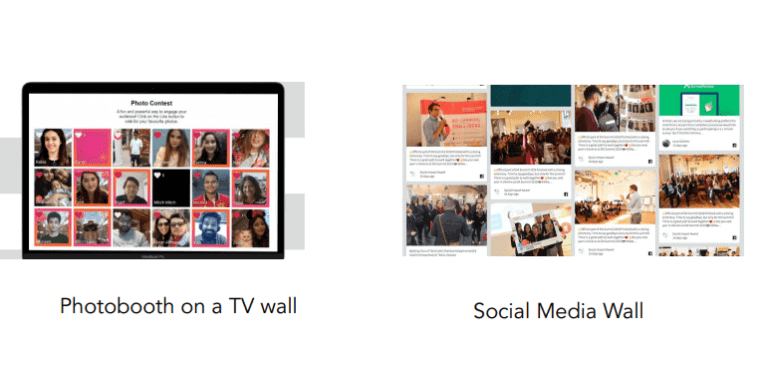
Event Engagement & Gamification Technology
“Gamified” events are the next big thing regarding event technology. Gamification is all about using games to give attendees a fun, immersive experience while also bringing new leads and people to the exhibitors’ booths. You can use interactive games like digital quizzes, polls, scavenger hunts, and trivia games at your event to get people excited and interested.
Practically, everyone likes games, so gamification is an excellent way to boost engagement at your event. Attendees get to interact and connect. You can also incentivize people to participate and then reward them with points.
For example, your in-person event guests will be thrilled by the excitement and enjoyment that the vFairs QR Scavenger Hunt provides. At the event, participants look for items labeled with a QR code, scan the code using the vFairs mobile app’s scanner, and get points for each item they find. At vFairs, you can modify the QR Scavenger Hunt with little effort. On the administrative end, you can assign points to as many different things as you choose.
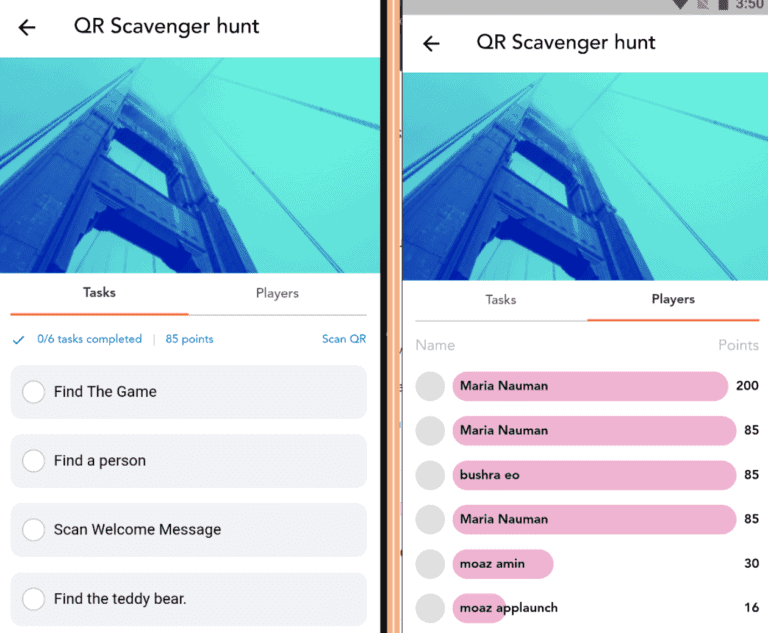
Event Reporting
Before there were event apps and platforms, event planners used surveys before and after the event to measure the return on investment (ROI). Such calculations rarely gave an accurate picture of how well an event did because the open rates rarely reached statistically significant percentages.
Since then, the game has changed. One of the best things about event technology is that it can help you get data insights and analytics reports. Planners need to find the right piece of technology that gives them the right analytics so they can measure the event KPIs that matter for their event. They can track customers behavior, lead generation, revenue and more.
Chapter 4: Attending an In-person Event
How to Find In-person Events to Attend
People use in-person events to create networks, find new professional opportunities and interact with their colleagues for fun and new learning opportunities. The hardest part is to find the best event. It is difficult for both event attendees and organizers to discover relevant events to participate in.
Today, you can use a number of event directories to find the best events happening. Even a simple google search can be useful. However, we recommend vFairs Discover where you can easily find events to attend, sponsor, and exhibit at. It is a specialized event marketplace where individuals can search for event topics and categories that are of interest to them.

How to Make the Most of an In-person Event
You’re spending precious time and possibly money attending an event. You need to make sure you get value out of it. Let’s go through a few ways you can do that before, during and after the event.
Pre-Event Prep
Prepping before any event you attend is highly recommended. At the very least, go through the event website or landing page, and the hosts’ site pages to get a good understanding of what the event will cover.
Make note of the themes, topics and activities in the event. Then choose what aspects of the event most interest you, and what you plan to take away from the event. If you have questions related to any discussion at the event, write them down!
If you want to take it a step further, start researching the speakers, sponsors and exhibitors who will be at the event as well. Look through their marketing sites, LinkedIn profiles and any other online presence they have. Again, it’s a great idea to write down questions you have related to their products, services, or areas of expertise.
This prep will help you identify exactly what your goals and anticipated takeaways are for the event, making you more likely to get active and involved throughout.
Record the Meetings
During the event, use audio or video recorders or just take digital notes to keep track of the information. Keep them in a place where you can find them. Once you have all the information given to you, you can decide what makes sense and what doesn’t. Also, you’ll be able to look back at the information a long time after the event. You just need to look at your records!
For example, if you are attending a conference, you can record it for later. The recording will be easily accessible to you anywhere and at any time. Moreover, listening to an event recording is a great way to have a deeper grasp of the conversation than you could have had otherwise.
Choose and Sort
There may be several talks and presentations at each event, especially if you’re attending conferences or summits. It would be impossible for a person to go to all of these, and it would be a waste of time. So, before you go to the event, it’s important to read about the sessions and pick out the ones that would be most helpful to you.
Find out who will be speaking and how useful the session will be for you. This way, you could skip the ones that aren’t important and save time. Your event also may publish recordings of the presentations afterward, so you can revisit them long after the event concludes!
Ask, Learn, and Connect
Speakers at professional events are usually leaders in their fields. Feel free to talk to them and ask questions while you’re listening to their talks. You can talk not only during the presentation but also after it is over. This will help you not only learn, but also get to know these pioneers.
Make Business Connections That Will Last
Even though learning is a benefit of going to professional events, networking is a huge benefit to in-person events. The main goal is to make connections. Meeting people from different parts of your field can help you make important long-term connections for your career.
Walk the floor and connect with people at exhibit booths. If the host offers a mobile app, search for other attendees you might want to meet onsite and send them a request to chat! Or, do it the old-fashioned way and strike up a conversation with the person next to you in line for coffee.
Chapter 5: Returning to In-Person Events
What Do In-person Events Look Like Post-COVID?
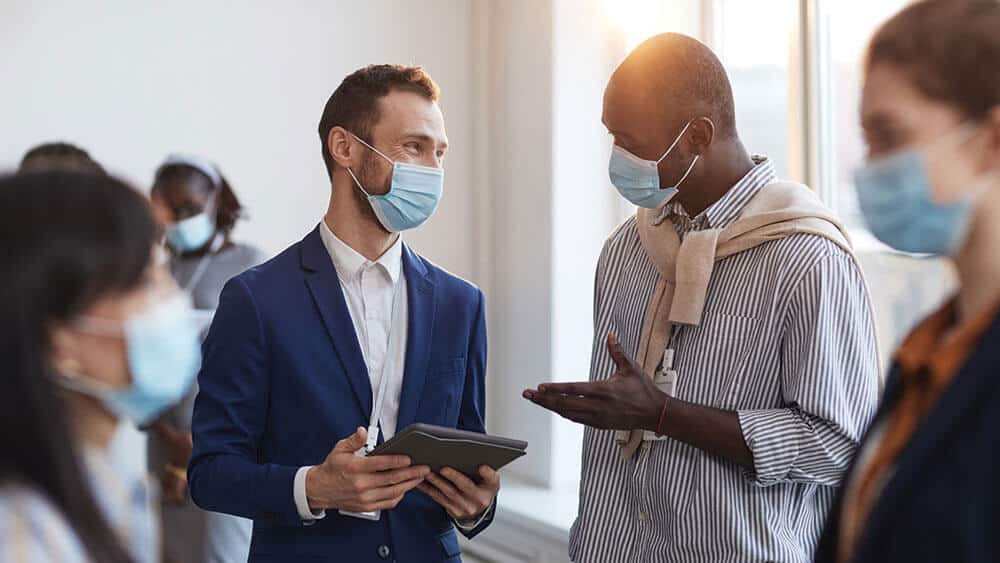
In the ‘new normal,’ we are adjusting to a post-pandemic environment. It is altering the way we work and interact with one another. Health and safety rules are a major factor in event planning in 2024. Maintaining social distance and indoor mask restrictions continue. COVID-19 numbers determine where the event will take place. This emphasizes the importance of timing and logistics.
Here are some of the ways events are accounted for the health and safety of their attendees:
- Registration: Attendees have to keep at least 6 feet of space between them while they wait in line to register, or this process is mostly online.
- Signage: Rules for social distance are written on the ground and put up to keep people safe.
- Session Rooms: Large round tables full of people are no longer allowed; planners have to change their plans for how many people can fit in each room.
- Expo Halls: Trade shows with a lot of people walking through them have become a thing of the past. Expo halls need to be open longer and have fewer people in them.
- Booths: Marketers had to change how they set up their freebies at expos and leave 6 feet of space between them and the next booth.
- Setting up the room: The chairs are set up in a way that encourages safe social distance.
- Activities: Networking and mixers aren’t a part of in-person events for a while. Planners have to figure out how to make up for this since social activities have always been a big draw.
The second major influence of the COVID pandemic era is the increased comfort level and reliance on technology. The Pandemic forced people to adopt new tech to continue functioning. This is bleeding into the in-person event experience. Here’s how:
- It helps people connect more easily.
- People can better personalize their experience (choosing presentations they want to attend, finding exhibitors they want to meet with easily, etc.)
- Event tech provides onsite activations that encourage cross-channel engagement e.g. social walls, leaderboards, photo booths, etc.
- Event tech ensures better event management. You can easily come onboard, register and check people in more easily.
- Event reporting is easier with better metrics for hosts.
- Features like interactive event floor maps help attendees with in-event navigation.
How Do You Host a Safe In-person Event?
Planning for events in 2024 and later should not be the same as planning for events in 2019. The world has changed and the fast digitization of the meetings and events industry has given us a lot of ways to keep people safe while giving them a great time at a physical event.
Make Sure Safety Measures Are Clear
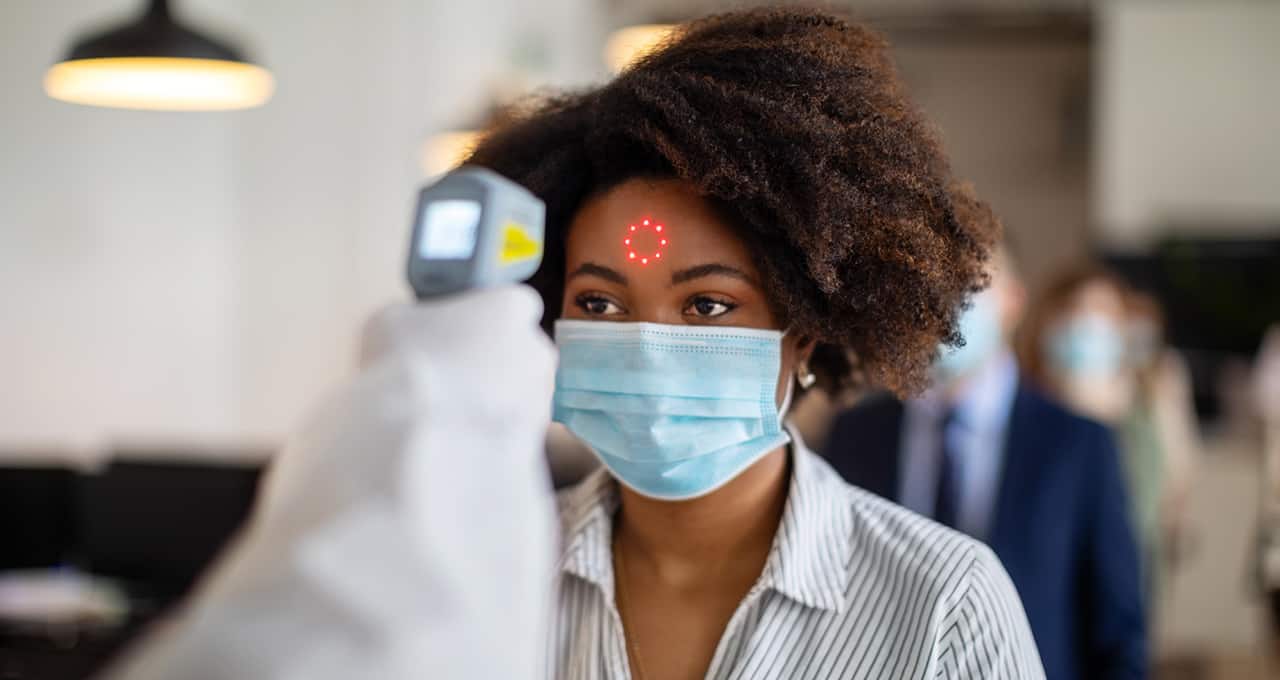
Your guests and employees need to know that their safety is important. But there’s a fine line between telling people about safety measures and making them the only thing they see when they look at an event’s invitation, website, or marketing materials.
People want to know that you’re on top of the situation, but they don’t want you to remind them of the pandemic all the time. You can conduct the following to ensure basic safety measures:
- Getting a form signed confirming your guests are vaccinated against covid OR asking for proof of a negative test taken within 24-48 hours before the event starts
- Forcing people to read through a list of safety measures as part of the registration process (they have to check a box saying I have read and agree to the health and safety requirements, and they can’t register if the box isn’t checked)
- Self-screening forms to fill in before guests check into the event. This is also a feature of the vFairs mobile app.
Make Safety A Key Aspect of Event Setup
When people get to the site, they don’t stop talking about safety. You can post signs showing traffic patterns, mask reminders, or social distance rules, as needed. Guests will probably want to see signs at the entrance and at the check-in desk that explain safety measures in more detail. They will also appreciate the whole setup. For example, you can arrange sanitizing stations, and handwashing stations and provide masks on-site.
Plan Room Layouts That Take Social Distancing into Account
Use tools for event diagramming to make room layouts that follow rules for social distance. Set up the chairs so that there is more space between them.
With the right tools, it’s easy to plan your event so that it follows social distance and safety rules and has the right number of people in each space.
You can also use diagramming tools to plan out where you’ll put hand-washing stations, mask stations, cleanliness stations mounted on the wall, and more in public areas.
Offer Touchless Check-in
People can check in and print their badges without touching any screens if they get a QR code or digital wallet information before the event. This way, you can keep people from touching each other and keep everyone healthy.
For example, vFairs makes it easy to check in at a live event because you don’t have to check the registration or payments by hand. If attendees pay through the registration site, they will get a QR code that they can scan at the venue to self-check in. Or, if you want attendees to check in themselves, they can scan a QR code to confirm the registration. You can also give each person a printed name tag. This will make it easy for people to check in at the event.
Offer Badge Printing
Badges are an important part of any professional event because they let people know who else is there and encourage networking. In the past, these badges were usually pre-printed in black and white and didn’t look very fine. Modern event badges, on the other hand, are much more beautiful and customizable. You can include custom colors, social media handles, photos, QR codes, and more. You may even build alternative attendee badges for different attendee categories using the inbuilt badge designer program.
vFairs lets people print their badges in real time so that they can be easily tracked and identified. vFairs can help you get all set up with the:
- badge printer
- wireless router
- switch for an Ethernet network.

This will save you the trouble of making badges and trackers by hand. There will be different types of lanyards and badges:
- Premium/Standard Event Badge
- Premium/Standard Lanyard
- Sticky labels on rolls for badges
Final Thoughts
While virtual and hybrid events have their own benefits, they can’t compete with in-person events. You can strengthen relationships by getting to know people in person at a physical meeting place. It’s not just about meeting people for the first time and making connections. Meeting in person is a great way to deepen relationships in a way that you can’t do online. Reach out to vFairs to schedule your next in-person event.
FAQs
Why are in-person events effective?
In-person events are great for hosts who want people to connect naturally. In comparison to other event formats, the face-to-face aspect of an in-person event is extremely beneficial for attendees to build connections, retain information, and stay connected with a brand throughout their experience.
Why is an event’s location important?
Location is important because it can affect how many people come to your event (attendees and speakers). If your venue is in an unattractive area or too far from places where people can get around, like airports, you won’t get as many people there.
How do you organize a successful in-person event?
Focus on things that will help you reach your event’s overall goal, such as learning activities and speakers. Once you know you have enough money for the big things, you can plan the venue, transportation, food, entertainment, and lodging.
What is the best event app?
With many options to choose from, in-person event apps all have some unique features. However, vFairs is the recommended one.
Being one of the top scorers at G2 reviews, vFairs has certainly made its mark in the events industry. We have been named the industry leader in G2 Reports, with an average rating of 4.7/5.
What is the biggest challenge while hosting an in-person event?
Non-experienced event planners often overspend while preparing for an in-person event. They plan and spend as they go, spending more than the budgeted amount. After they’ve made all the preparations, they realize their error.
To prevent overspending, always create a business event budget in advance. Before deciding, examine your budget. When choosing a venue, consider its whole cost. If the place is too pricey, choose another. You should also study event supplies and budget for catering, entertainment, and other essentials beforehand.
What are the three advantages of in-person events?
Three major pros for hosting an in-person event are: Human interactions, engaged audience, and personalized feedback.
Why are event activities important?
Event activities like leaderboard contests, games, ice-breaking sessions, etc can make your physical events much more engaging for the audience.


